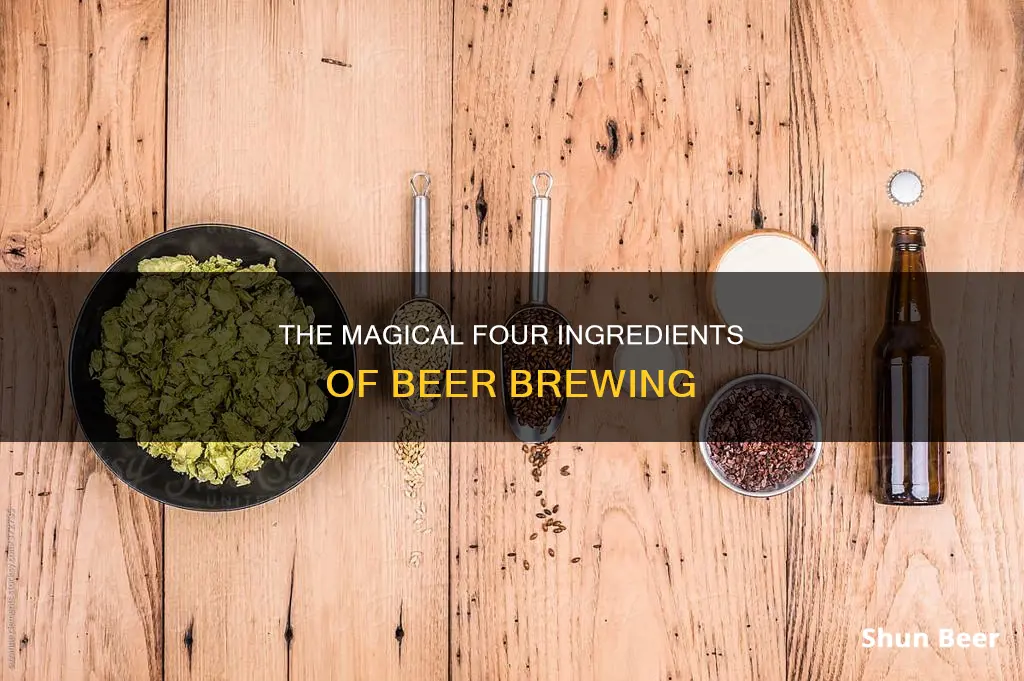
Beer is made from four main ingredients: grains, hops, yeast, and water. The grains used are usually malted barley, which have been soaked in water. The starches from these grains are turned into sugars, which interact with the yeast to create alcohol during the fermentation process. Hops are the flowers of the hop plant, Humulus lupulus, and they work as a bittering, flavouring, and stabilising agent within the beer. Yeast is a living fungal microorganism that is used in the fermentation stage to convert carbohydrates (sugars) into alcohol. Finally, water makes up around 90% of beer, so its quality is important to the final taste.
| Characteristics | Values |
|---|---|
| Number of Ingredients | 4 |
| Ingredients | Barley, Water, Hops, Yeast |
| Barley Preparation | Soaked in water, germinated, roasted |
| Barley Colour | Depends on roasting temperature |
| Water Content | 90-95% |
| Water Taste Impact | Minerals such as iron and lime can affect the taste |
| Hops Varieties | Bitter hops, aroma hops, double target hops |
| Hops Function | Flavouring, bittering, balance agent |
| Yeast Types | Ale yeast, lager yeast |
What You'll Learn

Barley must be malted before use
Barley is a key ingredient in beer brewing. However, it cannot be fermented into alcohol in its original form. Instead, it must first be converted into malted barley, or simply "malt", through a process called malting. This process involves three main steps: steeping, germination, and kilning.
Steeping
Malting begins with steeping, where the barley is soaked in water for a couple of days. This allows the grain to absorb moisture and activates naturally occurring enzymes. The water temperature and aeration are critical factors in this process, which typically lasts between 24 and 48 hours.
Germination
After steeping, the grain is transferred to a controlled environment where it is aerated, turned regularly, and maintained at a specific temperature to encourage germination. During this stage, the grain begins to sprout, making it more susceptible to the fermentation process. This process usually takes between 3 and 5 days.
Kilning
The final step in malting is kilning, where the germinated barley, now called "green malt", is slowly heated to stop the germination process. This step determines the color and flavor of the final malt. The temperature used during kilning can vary depending on the desired type of malt, with lower temperatures producing pale-colored beers and higher temperatures resulting in darker beers.
Malted barley is crucial to the brewing process as it provides the fermentable sugars that yeast feeds on to produce alcohol. Without malting, the starches and proteins in barley would not be accessible to the yeast, resulting in a less efficient fermentation process.
Hops' Preservative Powers: Keeping Beer Fresh
You may want to see also

Water quality impacts beer taste
Water quality is a key factor in the beer-making process and can significantly impact the final product's taste, aroma, and texture. Considering that beer is mostly water, the composition of the water used in brewing can greatly affect the quality of the beer.
Firstly, the mineral content of the water can have a notable influence on the taste of the beer. Different beer styles require different mineral compositions. For instance, a light lager typically calls for low mineral content, while a stout may benefit from a higher mineral content. Water with a high mineral concentration can create a more bitter taste, whereas water with low mineral content tends to produce a smoother, crisper flavour.
Secondly, the pH level of the water is crucial as it impacts the acidity of the beer. The ideal pH range for brewing beer is between 5.2 and 5.6, which is slightly acidic. If the pH deviates too far in either direction, the beer may become excessively bitter or sour, affecting its overall flavour.
Thirdly, the presence of certain contaminants in the water, such as chlorine or sulfur, can also impact the taste and aroma of the beer. Chlorine can impart a chemical taste to the beer, while sulfur can give it a rotten egg flavour. These contaminants are often added during municipal water treatment processes to eliminate harmful bacteria, but they can have undesirable effects on the beer's flavour and aroma.
Additionally, the softness or hardness of the water can play a role in the final product. Softer water tends to produce cleaner-tasting beer, which is why mountain spring water, known for its purity and lack of minerals, is highly valued by brewers. They can use this pristine water for their lagers and then add specific mineral salts to enhance the flavour profile, such as increasing the vibrancy of the hops in an IPA.
Water quality checks are essential in the beer-making process to ensure the desired taste and quality are achieved. Brewers may need to adjust the water composition by adding or removing certain minerals to create the perfect brew.
Hops in Beer: What Else Contains This Ingredient?
You may want to see also

Hops provide bitterness and aroma
Hops, the flower of the hop vine, are a key ingredient in beer, providing its distinctive bitterness and aroma. They contain alpha and beta acids, which are organic compounds that give beer its bitter flavour. Alpha acids are the main source of bitterness in beer, with the most common type being humulone. During the brewing process, alpha acids are degraded to form iso-alpha acids, which are more soluble and contribute to the bitterness associated with beer. The longer the hops are boiled, the more alpha acids are isomerised, increasing the bitterness of the beer.
Beta acids, on the other hand, have a harsher bitterness but are insoluble, so their contribution to the overall flavour is lower. They slowly oxidise over time, so their bitter flavour becomes more potent the longer the beer is fermented and aged.
In addition to bitterness, hops also contribute to the aroma of beer. Essential oils found in hops, such as myrcene, humulene, and caryophyllene, are responsible for the characteristic hoppy aroma. American hop varieties tend to have higher amounts of myrcene, which adds a citrus or piney aroma, while caryophyllene contributes a spicy flavour.
The type of hops used and the timing of their addition to the brewing process can significantly impact the bitterness and aroma of the final beer. Aroma hops, for example, are typically added late in the boil or during dry hopping to impart their aromatic qualities. Bittering hops, on the other hand, are added early in the boil to provide bitterness and stability to the beer.
Hops in Beer: Necessary or Overrated?
You may want to see also

Yeast is a living organism
Beer is made from just four ingredients: barley, water, hops, and yeast. While the first three are relatively familiar, yeast is a single-celled fungus, and a living organism. Yeast is a microorganism, and while it is too small to see with the naked eye, it is alive, like plants, animals, insects, and humans. In fact, the carbon dioxide we exhale when we breathe out is also released by yeast when it is active.
Yeast is usually inactive when purchased from a store, and it is preserved this way by keeping it cool and dry. However, when mixed with dough or added to a liquid with nutrients like sugar, it becomes active and starts consuming the sugar, breaking it down for food, and releasing carbon dioxide. This is why bread rises and becomes fluffy, and why beer becomes carbonated and alcoholic.
There are over 1,500 species of yeast, and it is one of the earliest organisms to be domesticated. Yeast used in baking is usually Saccharomyces cerevisiae, but there are many other species, and some live peacefully inside our bodies. Brewer's yeast and baker's yeast are different strains, with brewer's yeast acting more slowly and producing fewer off-flavours, while baker's yeast is more aggressive to carbonate dough faster.
Funky Buddha Hop Gun — A Hoppy Beer?
You may want to see also

Grains give beer its colour
Grains are the backbone of every beer, and they are responsible for its appearance and flavour. The grains used to make the malt largely affect the colour, smell, taste and head of the beer.
Barley is the base grain used in beer. It is soaked in water, germinated, and then roasted to dry out the grain and stop the germination process. The temperature of the roast affects the colour of the malted grain. Low temperatures create a pale malt that forms the basis of pale ales and lagers, while the highest temperatures make a dark, almost black malt used in porters and stouts.
The grain is coloured by melanin, which results in a rust-red pigmentation. To change this colour, specific chemical processes are required. The roasting process, also known as the Maillard Reaction or "browning", involves kilning or heating the germinated barley. The brewer determines the temperature of the kiln, which affects the final colour of the beer. The longer the grain is roasted, the darker its colour.
Other grains such as wheat, oats, rice, corn, and rye can also be used in the brewing process to change the flavour and mouthfeel of the beer. Wheat creates a fuller body and mouthfeel, while corn lightens the beer's body and decreases haziness. Oats are used in combination with barley to create a creamy and full-bodied brew, and rye is used to sharpen and add complexity to the flavour.
The Essential Ingredient in Beer: Hops or Not?
You may want to see also
Frequently asked questions
The four main ingredients of beer are water, barley, hops, and yeast.
Barley is a type of grain that undergoes a malting process before being used to make beer. This involves soaking the barley in water, allowing it to germinate, and then drying it to stop the germination process. The malted barley provides enzymes and sugars that are essential for fermentation.
Water makes up about 90% of beer and plays a crucial role in the fermentation process. The mineral content of water can vary depending on its source, and this can influence the taste of the beer.
Hops are the flowers of the hop vine, which is a relative of the hemp family. They contribute to the flavour, aroma, and bitterness of the beer. Hops also contain acids and oils that inhibit the growth of bacteria, helping to preserve the beer.







